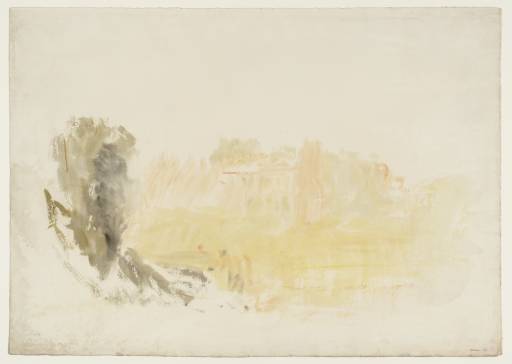Joseph Mallord William Turner Virginia Water c.1829
Joseph Mallord William Turner,
Virginia Water
c.1829
Joseph Mallord William Turner 1775–1851
Virginia Water c.1829
D25180
Turner Bequest CCLXIII 58
Turner Bequest CCLXIII 58
Watercolour on white wove paper, 362 x 510 mm
Blind-stamped with Turner Bequest monogram below centre
Stamped in black ‘CCLXIII – 58’ bottom right
Inscribed in red ink ‘58’ bottom right
Blind-stamped with Turner Bequest monogram below centre
Stamped in black ‘CCLXIII – 58’ bottom right
Inscribed in red ink ‘58’ bottom right
Accepted by the nation as part of the Turner Bequest 1856
References
1820
A.J. Finberg, A Complete Inventory of the Drawings of the Turner Bequest, London 1909, vol.II, p.818, CCLXIII 58, as ‘Landscape, with trees’, c.1820–30.
1997
Eric Shanes, Turner’s Watercolour Explorations 1810–1842, exhibition catalogue, Tate Gallery, London 1997, p.99 Appendix I ‘Literary and Book Illustrations’.
Finberg characterised this slight but atmospheric ‘colour beginning’ simply as a ‘Landscape with trees’, and it attracted little attention until Eric Shanes suggested its subject as Virginia Water,1 the artificial lake at the south end of Windsor Great Park, about five miles south of Windsor Castle. Turner had made numerous pencil studies around its banks in about 1827, in the Kenilworth sketchbook (mostly used on the subsequent Midlands tour of 1830), many of which focus on the Chinese-style ‘Fishing Temple’ on the north shore, which does not survive (Tate D22113–D22149; Turner Bequest CCCXXXVIII 71a–90); for a detailed discussion of the setting, see under D22113.
The distinctive building features in two engravings from closely related watercolours of about 1829, which appeared in the 1830 edition of the Keepsake annual (see the Introduction to this section). Virginia Water, No.I (Tate impressions: T04616, T04617, T06140) was taken from an untraced work2 showing the five bays of the symmetrical temple among trees reflected in the water in the left middle distance, a royal barge receding towards the right, and swans disturbing ducks in the foreground. Virginia Water, No.II (Tate impressions: T04618, T06141), from another watercolour (private collection),3 shows the afternoon sun low in a golden sky on the left, its glittering reflection emphasised by dark repoussoir trees dipping into the water at the left-hand edge. The pavilion is shown further off at an angle towards the centre, and a floating military band is towed by a smaller boat towards the right foreground; the lower centre is empty except for a solitary duck and two buoys painted with St George’s crosses. Shanes has discussed the likely symbolism and significance of these elements in relation to the actual and official birthdays of the artist and King George IV, a potential patron.4
The present colour study is relatively spare and unresolved, playing largely on the opposition of the golden wash, used indiscriminately albeit with practised skill for the building (articulated by lifting out the colour), distant trees and water, against the rough dark forms of the foliage in the left foreground. The latter feature and the sunlit colour informed the second of the finished designs, while the frontal and prominent positioning of the temple relates more to the relatively conventional composition of the first, where the sun is not shown within the image.5 As such, this ‘beginning’ may represent a half-way stage between the two, or a third independent option.
Verso:
Blank; stamped in black with Turner Bequest monogram over ‘CCLXIII – 58’ bottom left, and inscribed in pencil ‘CCLXIII. 58’ and ‘AB92P | O’ bottom right.
Matthew Imms
March 2017
How to cite
Matthew Imms, ‘Virginia Water c.1829 by Joseph Mallord William Turner’, catalogue entry, March 2017, in David Blayney Brown (ed.), J.M.W. Turner: Sketchbooks, Drawings and Watercolours, Tate Research Publication, July 2017, https://www

